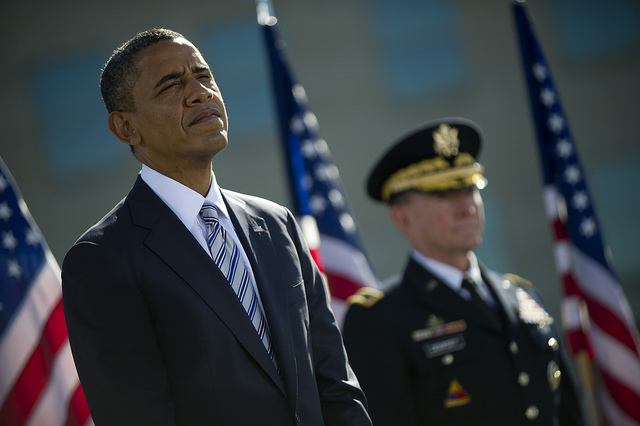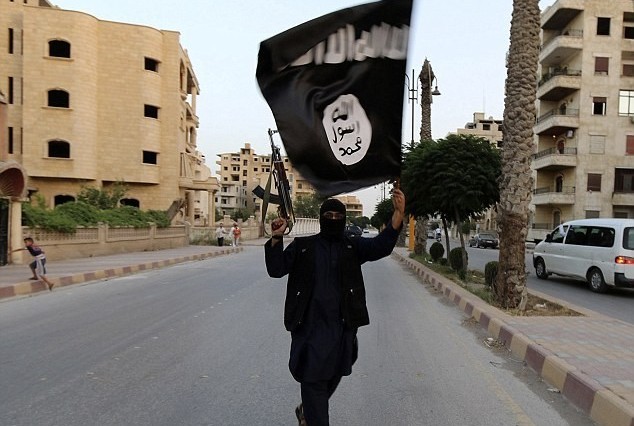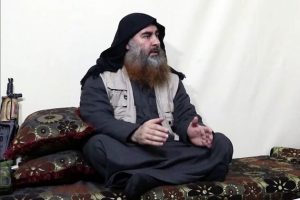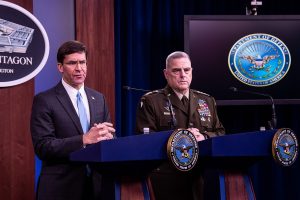by the National Security Network
This morning, the White House sent Congress the text of its proposed Authorization for Use of Military Force (AUMF) against the Islamic State. The proposed legislation includes strengths and weaknesses that deserve careful analysis and debate. Overall, the proposal would set important, if imperfect, limits on the war against the Islamic State, including: a three-year sunset clause, a careful definition of associated forces, and the repeal of the 2002 AUMF. But the proposal also includes a number of significant problems, including: a faux prohibition on large-scale ground combat operations that is effectively meaningless because of extremely poor wording, a lack of geographic limits, the potential application to ill-defined future “successors” of the Islamic State, and a failure to make clear the 2001 AUMF does not apply to the war against the Islamic State. This last step is important to prevent the current or future presidents from using the authority of the 2001 law to bypass any limitations in an Islamic State-specific authorization. The Obama Administration deserves credit for stepping up and offering an AUMF with some constructive provisions, but now the task is to use the congressional process to keep the good aspects, improve the imperfect aspects, and prevent worse provisions from being inserted into the proposal.
The good:
The proposed AUMF includes a sunset clause which is important to make sure the conflict is reassessed in the future and to prevent the next president from dramatically changing war policy without congressional approval. As the National Security Network (NSN) explained in our paper on an Islamic State AUMF in September 2014, there are two reasons why a sunset clause is important: “First, the complexities of a sustained military campaign against the Islamic State…carry significant risks to the soundness of U.S. strategy. Even if the idea is appealing at present, there are a number of variables outside of U.S. control that could significantly affect the calculus of policymakers. For example, Iraqi politics may be unable to deliver inclusive governance. Or moderate Syrian rebels may be unable or unwilling to deliver battlefield victories against the Islamic State or could cooperate with Salafi extremists to unacceptable extents, possibly including the transfer of U.S-provided war materiel. Second, because the conflict will very likely continue into the tenure of the next president, Congress and the American people should receive the opportunity to check the war policy of an as-yet undetermined next Administration.” [NSN, 9/18/15]
Including temporal limits in the proposed AUMF is in line with the precedent set by past war authorizations, 23 percent of which included expirations.
The proposed AUMF applies to “associated forces” in a way that is consistent with traditional, narrow meanings of term.The White House’s proposal authorizes force specifically against the Islamic State and associated forces, carefully defined. The draft reads, “the term ‘associated persons or forces’ means individuals and organizations fighting for, on behalf of, or alongside ISIL or any closely-related successor entity in hostilities against the United States or its coalition partners.” This is the traditional meaning of associated forces, which Jeh Johnson explained clearly during his tenure as General Counsel at the Department of Defense in the context of al-Qaeda’s associated forces under the 2001 AUMF: “(1) an organized, armed group that has entered the fight alongside al Qaeda, and (2) is a co-belligerent with al Qaeda in hostilities against the United States or its coalition partners. In other words, the group must not only be aligned with al Qaeda. It must have also entered the fight against the United States or its coalition partners. Thus, an ‘associated force’ is not any terrorist group in the world that merely embraces the al Qaeda ideology.” This clarity and precise application to the Islamic State and associated forces is important, particularly given past draft AUMFs in Congress have failed to give precise definitions of associated forces. For example, last year Rep. Frank Wolf (R-VA) offered an AUMF that would have authorized conflict across a very general and vague scope, including against those “associated with or supporting terrorist groups” of any kind, including those “groups that share a common violent extremist ideology.” [Jeh Johnson, 2/22/12. Frank Wolf, accessed 2/11/15]
The proposed AUMF would repeal the 2002 AUMF that George Bush used to invade Iraq. A group of legal scholars including Harold Koh of Yale Law School explain the significance of repealing the 2002 law: “An ISIL-specific AUMF would eliminate any continuing justification for keeping the 2002 Iraq AUMF on the books; and would clarify current U.S. objectives in Iraq, which are quite distinct from those described in the 2002 AUMF, a statute designed for an earlier and different armed conflict against a different enemy.” [Harold Koh, 11/14]
The bad:
The proposed AUMF’s limitation on ground forces is worded in a way that may render it effectively meaningless. The White House’s AUMF states that it “does not authorize the use of the United States Armed Forces in enduring offensive ground combat operations.” However, as NSN Senior Advisor Maj. Gen. Paul Eaton (Ret.) explains, “The definition of ‘enduring offensive ground combat operations’ seems to be in the eye of the beholder. To my knowledge, the term ‘enduring’ has no significant doctrinal or operational meaning. Ultimately, the whole phrase is soft enough that it simply authorizes the Pentagon to conduct offensive ground combat operations without clear limitation.” Previous AUMF proposals included much more precise language regarding limitations on ground operations. For example, Sen. Robert Menendez’s (D-NJ) draft bill last year prohibited “the use of the United States Armed Forces for the purpose of ground combat operations” except for specific kinds of operations, such as “(i) intelligence collection and sharing; (ii) enabling kinetic strikes; (iii) operational planning; or (iv) other forms of advice and assistance to forces fighting ISIL in Iraq or Syria.” [Paul Eaton, 2/11/15. SFRC Draft, accessed 2/11/15]
Conservatives have already signaled displeasure with limiting the role of ground forces, but historically 37 percent of war authorizations have included operational limits or limits on the kinds of forces that could be employed.
The proposed AUMF places no geographic limits on where the United States can use military force against the Islamic State. This leaves the door open to authorizing expansive conflict in diverse locations, each with a unique set of considerations deserving of debate and congressional approval. At present, the United States is conducting operations against the Islamic State in Iraq and Syria, but satellite groups operating outside this theater have pledged their allegiance to the organization. “The Islamic State announced several months ago that it was ‘annexing’ territory in Algeria (Wilayat al-Jazair), Libya (Wilayat al-Barqah, Wilayat al-Tarabulus and Wilayat al-Fizan), Sinai (Wilayat Sinai), Saudi Arabia (Wilayat al-Haramayn) and Yemen (Wilayat al-Yaman). It is likely that the Islamic State plans to pursue a similar approach in Afghanistan andPakistan,” according to Aaron Zelin, Richard Borow Fellow at the Washington Institute for Near East Policy. This may set up a repeat of the 2001 AUMF that enabled an expansive, unforeseen war. As Sen. Dick Durbin (D-IL) said of the snowballing geographic scope of the 2001 AUMF, “None of us, not one who voted for it, could have envisioned…that we were about to give future presidents the authority to fight terrorism as far flung asYemen and Somalia.” [Aaron Zelin via Washington Post, 1/28/15. Dick Durbin via Politico, 5/7/13]
Placing geographic limits in the Islamic State AUMF is well within historical precedent as 60 percent of war authorizations have included geographic limits.
The ugly:
The proposed AUMF does not restrict using the 2001 Authorization to bypass the limits set in an Islamic State-specific law. The Administration has already claimed that the 2001 AUMF gives them the necessary authority to engage in armed conflict against the Islamic State. American University law professor Steve Vladeck explains the implications: “so long as the 9/11 AUMF remains on the books, these constraints [in an Islamic State AUMF] are little more than hortatory; nothing in the new bill would stop this government (or its successors) from relying upon the 2001 statute—which includes no similar sunset or reporting requirements—to use force against ISIL or any other group that the executive branch (secretly) determines is an ‘associated force’ of al Qaeda or the Taliban” in order to bypass the limits contained in an Islamic State AUMF. A previous draft bill by Sen. Menendez addressed this problem by stating: “The provisions of this section pertaining to the authorization of use of force against the Islamic State of Iraq and the Levant shall supersede any preceding authorization for the use of military force.” [Steve Vladeck, 2/11/15. SFRC Draft, accessed 2/11/15]
The proposed AUMF could apply to ill-defined future organizations that do not even exist yet. The draft text says it would authorize use of force against any “closely related successor entity.” This raises questions about what exactly that could mean, ranging from relatively benign to disturbing. On the one hand, closely related successors could simply mean the Islamic State following a change of names or re-branding. On the other hand, it could apply to potentially markedly different organizations with different objectives, different modes of operation, and that present a very different threat—if any—to the United States.
Photo of President Obama and Army General Martin Dempsey
Reprinted with permission from the National Security Network






There all sorts of things wrong with this AUMF, and many of them are clarified here. One that caught my eye was one of the “whereas” stipulations:
“Whereas ISIL leaders have stated that they intend to conduct terrorist attacks internationally, including against the United States, its citizens, and interests.”
Threats to the Homeland. This opens up the possibility of future publicity-seeking, recruit-gaining, funds-desiring wannabes. Threaten a terrorist attack on the U.S. and get your name in lights, with your very own AUMF and billions in arms to your enemies, which will eventually make their way to you!
from CNN, Nov 1, 2004:
The Arabic-language network Al-Jazeera released a full transcript Monday of the most recent videotape from Osama bin Laden in which the head of al Qaeda said his group’s goal is to force America into bankruptcy. “We are continuing this policy in bleeding America to the point of bankruptcy. Allah willing, and nothing is too great for Allah.”
But hey, it’s another war to cowboy up for and great for the Pentagon budget.
I thought the US was already using force against ISIS. It’s like the Crusades all over again.
That belated AUMF takes care of Operation Inherent Resolve, how about the others?
There are a few others including:
–Operation Enduring Freedom – Philippines (OEF-P)
–Operation Enduring Freedom – Horn of Africa (OEF-HOA) Somalia extended into Yemen
–Operation Enduring Freedom – Trans Sahara (OEF-TS) in North Africa
–Operation Enduring Freedom – Caribbean and Central America (OEF-CCA)
also some other military operations:
–Atlantic Resolve (with NATO in Europe)
–Freedom’s Sentinel (with NATO’s Resolute Support Mission in Afghanistan)
–Martillo (Hammer) targeting illicit drug trafficking in coastal waters along the Central American isthmus
Can’t say that “O” didn’t give the gift “that keeps on giving”. I wonder, do they also label all the actions where the U.S.Military are involved in those 130+ countries, any which one could end up in a major conflict? You really have to “love/hate” all those people willing to send the “Youth” of America to fight, while they sit on their backsides puffing out their chests bleating like a pack of jack-ass’s they be.